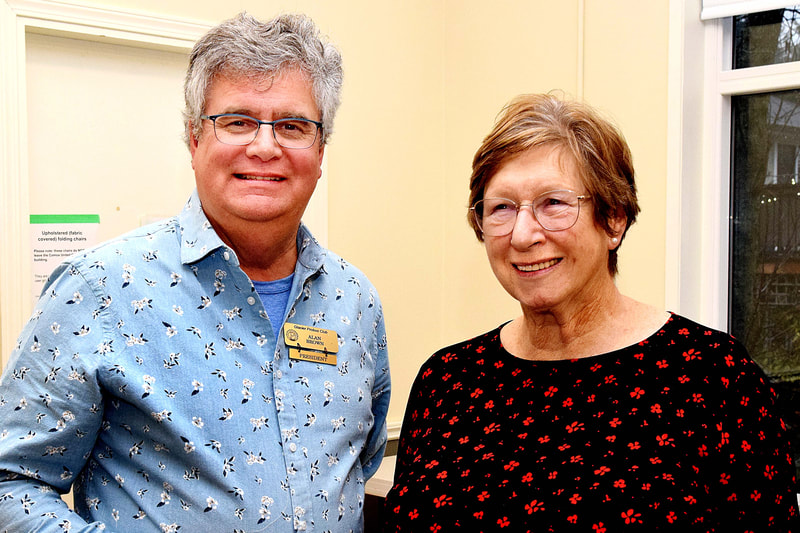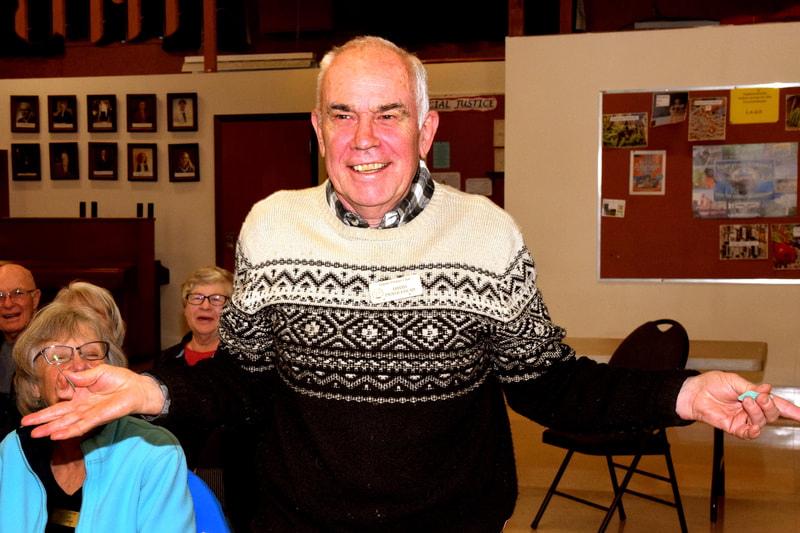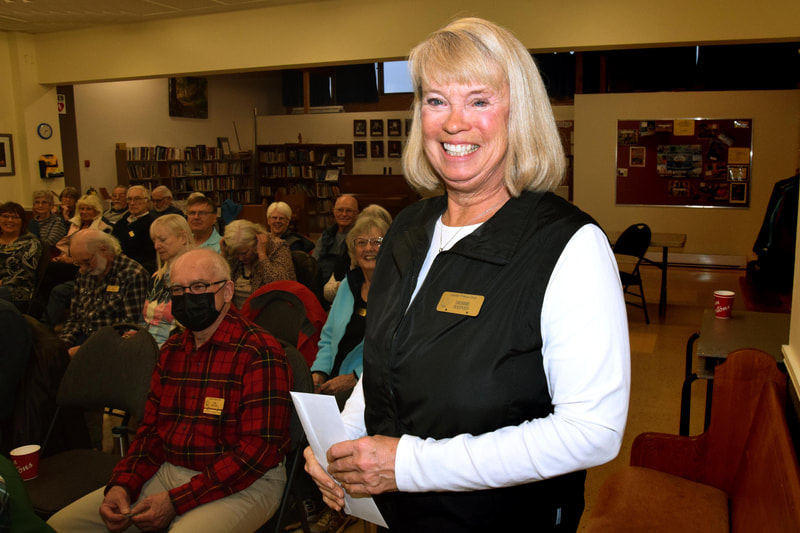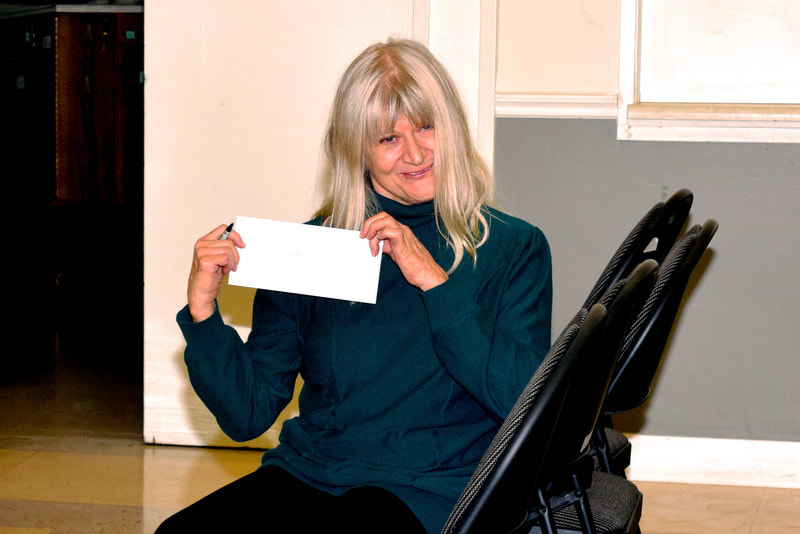President Alan Brown welcomed 53 club members to our January GM with a joke and a Happy New Year. He welcomed Christine Dickinson, our guest speaker. Christine was born and educated in New Zealand but lived and worked as an educator for 34 years in northern BC moving to the Comox Valley in 2007. Her passion is for the regional history of the province, and she has co-authored Atlin: The Story of British Columbia's Last Gold Rush and Watershed Moments: A pictorial History of Courtenay and District. Christine is a contributing author to Step into Wilderness: A Pictorial History of Outdoor Exploration in the Comox Valley.
Christine's talk concentrated on the Beginnings of Tourism in the Comox Valley. Tourism didn't start in the valley until quite a while after the first settlers who fished and hunted out of necessity. These activities were otherwise only available to the leisure or wealthy classes of Victoria who went to Duncan for these activities. The Royal Navy trainees enjoyed fished and hunting for rest and recuperation and tourism in Campbell River grew.
But this all changed when Clinton Wood, a teacher, bookkeeper, and sawmill engineer, moved to Courtenay in 1910. He worked for Comox Logging and Rail and built houses at Headquarters. He worked for the Power & Light Company from 1910-12 and travelled around by bicycle wiring houses even in Cumberland.
In 1922 he became Courtenay City Clerk charged with developing a water system from Brown River following the big fire of 1916. No one knew the headwaters of Brown River, except the local First Nations. Cecil Smith (known as Cougar Smith) believed it had multiple sources, McKenzie Lake being one. Exploring with Cecil, Clinton was overwhelmed with the beautiful meadows, rolling hills dotted with lakes, lush trees, and spectacular scenery. Clinton saw economic prospects with this back country hidden gem. He brought members of Courtenay City Council and Board of Trade up the almost fourteen miles to a meeting in the wilderness to see his vision.
On July 6, 1926 Clinton and Cougar set off with two saddle horses on their first trip to Mount Albert Edward from the trail at Bevan and up to Mount Becher and on to the Forbidden plateau. The following year he returned with the president of the Vancouver Island section of the Alpine Club of Canada. This resulted in a joint Alpine Club and Courtenay-Comox Mountaineering Cub (CDMC) camp in the summer of 1928 on the plateau. The rustic Mt. Becher cabin was built and was filled with groups of people most weekends summer and winter for fun and games. Over the years the cabin improved with bunks and a wood stove that Sid Williams carried on his back up to the cabin. The cabin became a labour of love. Previously skiing was not known in the West and in the 1920s the group began to ski making their own primitive skis (and developing the Becher Squat). In the late 1920s they even had a Ski Meet which was won by the Scandinavians. By spring there would be 15-20 feet of snow and one had to dig down to get in the door. But great fellowship and good humour was enjoyed by the likes of Ruth Masters and Marjorie Briscoe.
Clinton realized that an easier trail through Bevan to the plateau was needed. With some government money but mostly volunteer money from the local CDMC, the Dove Creek Trail was built. It started at the end of Dove Creek Road to Anderson Lake Road to Paradise Meadows to Battleship and Croteau Lake. The Trail was officially opened by Lieutenant-Governor the Honorable Randolph Bruce and a number of local dignitaries including Courtenay Mayor Theed Pearse and his wife, Elma, Clinton Wood, now President of the CCMC, George McNaughton a GP from Cumberland, and Miss Helen McKenzie , a niece of Randolph Bruce. Clinton stated that, "the Trail would bring within a half days travel, a new Switzerland, allowing people to go up into higher altitudes".
In the 1890s, Eugene Croteau came to BC from Quebec. He was involved with sawmills, mining, and real estate. In 1917 he worked for the Comox Logging Company as a log scaler and time keeper. He purchased a five acre property on Croteau Beach and was a neighbour of Mack Laing. Croteau was a restless fellow and in 1930 built a log cabin at the foot of Mt. Elna. He began a business guiding celebrity guests such as film stars and a Russian prince to his camp. After the almost fourteen mile walk or horse ride, the guests were accommodated in tents with proper beds. Breakfast in bed was provided with real maple syrup from Quebec. The cabin on site was the cookhouse where clam chowder, chicken mulligan, and huckleberry pie were whipped up by cooks such as Ruth Masters who was the cook in 1939. While the adventurous men climbed the local mountains, the women rambled or sketched and painted the scenery. In the evenings Eugene was a great raconteur singing and telling stories.
Then WW2 broke out and there were no longer any available packers or guides. By 1942, Croteau, now 81, having done twelve trips by himself in one year, retired and that was the end of Croteau's Camp.
Clinton Wood still wanted to invest in this magnificent playground and in 1934 built the Forbidden Plateau Lodge as a guest lodge which they operated for eleven years before retiring. His son, Stuart, was an integral part of this development and helped in the building of a railway, a telephone line, and a power plant for the lodge. The Wood men operated a packhorse team for mountaineers and tourists. They built a road with at least seven switchbacks by dragging a V-shaped contraption behind the horses. Stuart went to UBC for guiding and in 1941 joined the RCAA. His plane went missing over Cologne devastating Clinton who withdrew and sold the business. Finally the Lodge was acquired and designated a Class A Provincial Park in 1962.
The development of tourism in Comox is a totally different story. The settlers included Sidney D'Esterre, "Dusty" who was a rich Anglo-Irish man making his money from diamonds in South Africa. He served in the British Navy in the 20s and 30s. In 1862 James Robbb and his son attempted to start their own town with land from Anderton Road to the Stewart waterfront to Noel Avenue. However, they were charging so much for the lots that nobody wanted to buy. James Dunsmuir who was developing coal in Cumberland had a barge crossing to Comox but he even said Robb wanted too much. In the 1920s, there were still only a handful of lots sold.
Dusty D'Esterre bought the property up and build the Elk Inn. The timing was fortuitous occurring at the end of prohibition. Making a profit, the large plot of land was re-surveyed into larger lots and the first early homes in Comox were built from 1920-1928.
But Dusty had bigger plans putting in electric lights, a wide carpeted staircase and stairways in the Elk Inn where tourists could lounge and talk about their fishing adventures. The menu was locally sourced meat, fish, dairy, strawberries, etc. Dusty took people tie fishing and started up the tie fishing club, named the Comox King Salmon Club. His competitions to catch the biggest salmon with a rod and 9 strand line drew celebrities such as Bing Crosby and Ginger Rogers. He also put up bathing boxes at Kye Bay and Goose Spit and developed the Comox Golf Course and tennis courts.
The Port Augusta Hotel was developed as a family hotel where one did one's own cooking and cleaning.
Eventually the waters became overfished and tie fishing ended. During the 1950s motels became popular with Laing's Beach Resort offering comfortable bungalows which developed into today's Kingfisher Resort. That was the end of "the beginning" of tourism in the Comox Valley.
Question Period: A member asked how the time frame of the start of tourism in the valley coincided with the development of Banff. Christine stated that Strathcona Park was the first Provincial Park in BC coming in on the coattails of the development of Banff.
Alan Brown thanked Christine for her informative talk noting it was interesting to hear about the people behind the local street names.
Winners of the Big Foot Gift Certificates were: Christine Dickinson David Pendlebury, Deb Haines, and myself, Jill Almond
Pictures compliments of Ian Thompson.
Christine's talk concentrated on the Beginnings of Tourism in the Comox Valley. Tourism didn't start in the valley until quite a while after the first settlers who fished and hunted out of necessity. These activities were otherwise only available to the leisure or wealthy classes of Victoria who went to Duncan for these activities. The Royal Navy trainees enjoyed fished and hunting for rest and recuperation and tourism in Campbell River grew.
But this all changed when Clinton Wood, a teacher, bookkeeper, and sawmill engineer, moved to Courtenay in 1910. He worked for Comox Logging and Rail and built houses at Headquarters. He worked for the Power & Light Company from 1910-12 and travelled around by bicycle wiring houses even in Cumberland.
In 1922 he became Courtenay City Clerk charged with developing a water system from Brown River following the big fire of 1916. No one knew the headwaters of Brown River, except the local First Nations. Cecil Smith (known as Cougar Smith) believed it had multiple sources, McKenzie Lake being one. Exploring with Cecil, Clinton was overwhelmed with the beautiful meadows, rolling hills dotted with lakes, lush trees, and spectacular scenery. Clinton saw economic prospects with this back country hidden gem. He brought members of Courtenay City Council and Board of Trade up the almost fourteen miles to a meeting in the wilderness to see his vision.
On July 6, 1926 Clinton and Cougar set off with two saddle horses on their first trip to Mount Albert Edward from the trail at Bevan and up to Mount Becher and on to the Forbidden plateau. The following year he returned with the president of the Vancouver Island section of the Alpine Club of Canada. This resulted in a joint Alpine Club and Courtenay-Comox Mountaineering Cub (CDMC) camp in the summer of 1928 on the plateau. The rustic Mt. Becher cabin was built and was filled with groups of people most weekends summer and winter for fun and games. Over the years the cabin improved with bunks and a wood stove that Sid Williams carried on his back up to the cabin. The cabin became a labour of love. Previously skiing was not known in the West and in the 1920s the group began to ski making their own primitive skis (and developing the Becher Squat). In the late 1920s they even had a Ski Meet which was won by the Scandinavians. By spring there would be 15-20 feet of snow and one had to dig down to get in the door. But great fellowship and good humour was enjoyed by the likes of Ruth Masters and Marjorie Briscoe.
Clinton realized that an easier trail through Bevan to the plateau was needed. With some government money but mostly volunteer money from the local CDMC, the Dove Creek Trail was built. It started at the end of Dove Creek Road to Anderson Lake Road to Paradise Meadows to Battleship and Croteau Lake. The Trail was officially opened by Lieutenant-Governor the Honorable Randolph Bruce and a number of local dignitaries including Courtenay Mayor Theed Pearse and his wife, Elma, Clinton Wood, now President of the CCMC, George McNaughton a GP from Cumberland, and Miss Helen McKenzie , a niece of Randolph Bruce. Clinton stated that, "the Trail would bring within a half days travel, a new Switzerland, allowing people to go up into higher altitudes".
In the 1890s, Eugene Croteau came to BC from Quebec. He was involved with sawmills, mining, and real estate. In 1917 he worked for the Comox Logging Company as a log scaler and time keeper. He purchased a five acre property on Croteau Beach and was a neighbour of Mack Laing. Croteau was a restless fellow and in 1930 built a log cabin at the foot of Mt. Elna. He began a business guiding celebrity guests such as film stars and a Russian prince to his camp. After the almost fourteen mile walk or horse ride, the guests were accommodated in tents with proper beds. Breakfast in bed was provided with real maple syrup from Quebec. The cabin on site was the cookhouse where clam chowder, chicken mulligan, and huckleberry pie were whipped up by cooks such as Ruth Masters who was the cook in 1939. While the adventurous men climbed the local mountains, the women rambled or sketched and painted the scenery. In the evenings Eugene was a great raconteur singing and telling stories.
Then WW2 broke out and there were no longer any available packers or guides. By 1942, Croteau, now 81, having done twelve trips by himself in one year, retired and that was the end of Croteau's Camp.
Clinton Wood still wanted to invest in this magnificent playground and in 1934 built the Forbidden Plateau Lodge as a guest lodge which they operated for eleven years before retiring. His son, Stuart, was an integral part of this development and helped in the building of a railway, a telephone line, and a power plant for the lodge. The Wood men operated a packhorse team for mountaineers and tourists. They built a road with at least seven switchbacks by dragging a V-shaped contraption behind the horses. Stuart went to UBC for guiding and in 1941 joined the RCAA. His plane went missing over Cologne devastating Clinton who withdrew and sold the business. Finally the Lodge was acquired and designated a Class A Provincial Park in 1962.
The development of tourism in Comox is a totally different story. The settlers included Sidney D'Esterre, "Dusty" who was a rich Anglo-Irish man making his money from diamonds in South Africa. He served in the British Navy in the 20s and 30s. In 1862 James Robbb and his son attempted to start their own town with land from Anderton Road to the Stewart waterfront to Noel Avenue. However, they were charging so much for the lots that nobody wanted to buy. James Dunsmuir who was developing coal in Cumberland had a barge crossing to Comox but he even said Robb wanted too much. In the 1920s, there were still only a handful of lots sold.
Dusty D'Esterre bought the property up and build the Elk Inn. The timing was fortuitous occurring at the end of prohibition. Making a profit, the large plot of land was re-surveyed into larger lots and the first early homes in Comox were built from 1920-1928.
But Dusty had bigger plans putting in electric lights, a wide carpeted staircase and stairways in the Elk Inn where tourists could lounge and talk about their fishing adventures. The menu was locally sourced meat, fish, dairy, strawberries, etc. Dusty took people tie fishing and started up the tie fishing club, named the Comox King Salmon Club. His competitions to catch the biggest salmon with a rod and 9 strand line drew celebrities such as Bing Crosby and Ginger Rogers. He also put up bathing boxes at Kye Bay and Goose Spit and developed the Comox Golf Course and tennis courts.
The Port Augusta Hotel was developed as a family hotel where one did one's own cooking and cleaning.
Eventually the waters became overfished and tie fishing ended. During the 1950s motels became popular with Laing's Beach Resort offering comfortable bungalows which developed into today's Kingfisher Resort. That was the end of "the beginning" of tourism in the Comox Valley.
Question Period: A member asked how the time frame of the start of tourism in the valley coincided with the development of Banff. Christine stated that Strathcona Park was the first Provincial Park in BC coming in on the coattails of the development of Banff.
Alan Brown thanked Christine for her informative talk noting it was interesting to hear about the people behind the local street names.
Winners of the Big Foot Gift Certificates were: Christine Dickinson David Pendlebury, Deb Haines, and myself, Jill Almond
Pictures compliments of Ian Thompson.



